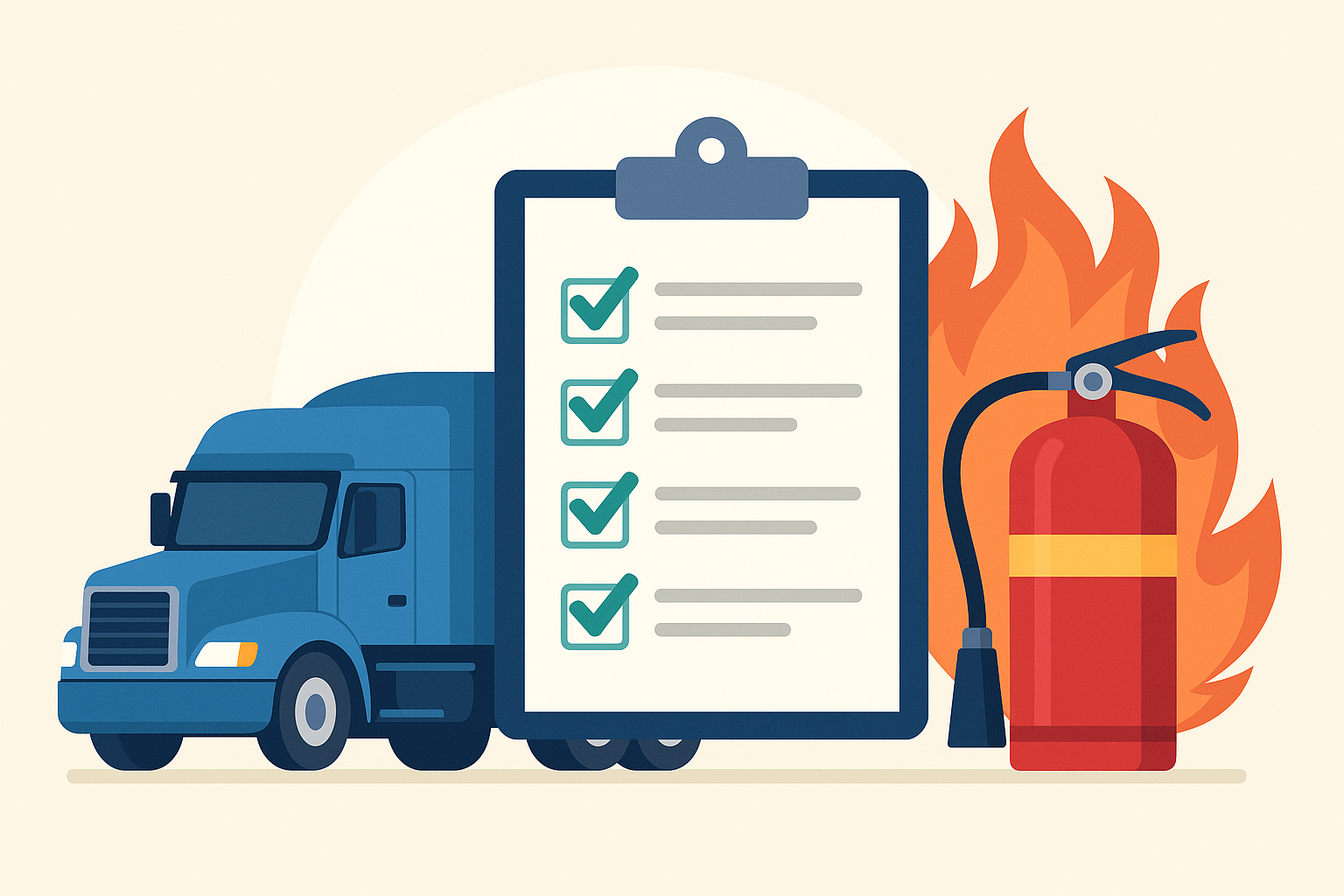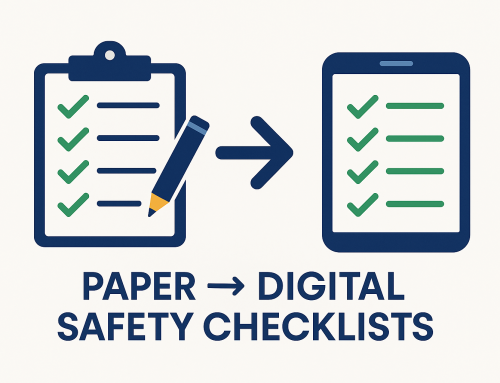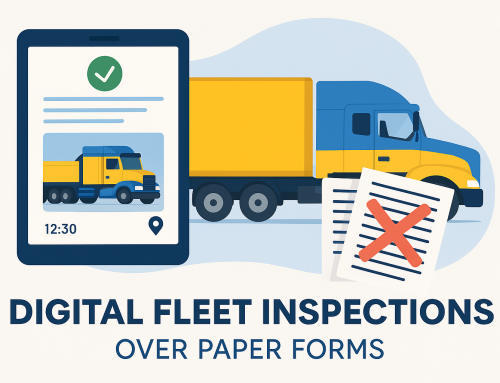Truck Fires: Common Risks in Heavy Vehicles and How to Prevent Them
Among the most dangerous incidents a transport operator can face are truck fires. Electrical faults, fuel leaks, and overheated brakes can escalate in seconds, endangering drivers and crippling operations. This guide outlines the leading heavy vehicle fire risks, practical prevention measures, and how digital checklists like DIGI CLIP provide verifiable evidence through photos, geo‑time stamping, and signatures—so you can prove compliance under WHS and CoR obligations.
Quick Highlights
- Common causes include electrical faults, fuel/oil leaks, and overheated brakes or wheel ends.
- Daily pre‑starts + scheduled servicing reduce ignition sources and fuel loads.
- DIGI CLIP captures photo evidence, geo‑time stamps, and signatures for audit‑ready records.
- Action Register ensures hazards and corrective actions stay tracked until closed.
Table of Contents
Common Causes of Truck Fires
Fire requires heat/ignition, fuel, and oxygen. In heavy vehicles, typical ignition and fuel sources arise from:
- Electrical faults — chafed looms, poor earths, unprotected accessory wiring, corroded terminals.
- Fuel and oil leaks — tank, hose, or injector leaks contacting hot exhaust/turbo surfaces.
- Overheated brakes and wheel ends — dragging brakes, seized calipers, under‑inflation, bearing failures.
- Exhaust and DPF heat — parked regeneration near combustibles, failed heat shields, debris build‑up.
- Poor housekeeping — leaf litter, rags, or grease accumulations in engine bays and under‑body areas.
Truck Fire Prevention Strategies
- Daily pre‑start inspections to detect leaks, damage, loose shielding, and wiring issues early.
- Planned maintenance with special focus on brakes, bearings, wheel ends, electrical systems, and DPFs.
- Housekeeping — keep engine bays and trays free from debris and combustible residues.
- Fire equipment — carry correct‑type extinguishers, mount securely, service and tag per schedule.
- Driver training — recognise warning signs (smell of burning, smoke, dragging brake), safe pull‑over and response.
- Evidence‑based reporting using digital checklists for traceable, time‑stamped inspections and actions.
Truck Fire Safety & Compliance
Under WHS duties and Chain of Responsibility (HVNL), operators must ensure vehicles are safe, risks are managed, and defects are rectified. Audit‑ready records and close‑out evidence reduce prosecution and insurance exposure. Useful references include Safe Work Australia: Managing risks and the EU‑OSHA comparative report on smart digital systems for OSH (download PDF).
Truck Fire Risk Management with DIGI CLIP
- Mobile fire safety and pre‑start checklists with photo capture for defects and hazards.
- Geo‑time stamping and digital signatures for verifiable inspections and corrective actions.
- Automated alerts to notify managers when heat, smoke, or leak hazards are reported.
- Central Action Register — assign, track, and close corrective actions with proof of completion.
Deep‑dive further with these related resources:
- Digital vehicle inspection checklists for logistics
- Digital checklists for workplace safety
- Top benefits of digital inspection apps for compliance
- Industry‑specific digital checklists
External authority: RMIT — Using digital technology to share health and safety knowledge (PDF).
Paper vs Digital: Fire Safety Management
| Aspect | Paper Process | Digital with DIGI CLIP |
|---|---|---|
| Evidence capture | Handwritten, photos separate or missing | Photos in‑form, geo‑time stamped, signatures |
| Defect follow‑up | Emails/phone calls; hard to track | Action Register assigns, tracks, and verifies closure |
| Audit readiness | Files scattered; gaps likely | Central, searchable records; instant export |
| Speed & accuracy | Slow, error‑prone | Guided fields, alerts, instant notifications |
How to Roll Out a Truck Fire Prevention Checklist
- Map critical fire risks (electrical, wheel ends, fuel/oil, DPF/exhaust, housekeeping).
- Configure a digital pre‑start & fire safety checklist with photo and signature fields.
- Train drivers and fitters to capture clear, close‑up defect photos.
- Set email alerts for any “No/Not OK” item tagged to fire risk.
- Route defects to the Action Register, assign owners, and set due dates.
- Verify completion with follow‑up photos and digital sign‑off.
- Review monthly analytics, target repeat causes, and update the checklist.
FAQs
What causes most truck fires?
Electrical faults, fuel/oil leaks contacting hot surfaces, and overheated brakes or wheel ends.
How often should fire safety checks be done?
Daily pre‑starts plus scheduled servicing; increase frequency after major repairs or heavy‑duty use.
Are fire extinguishers mandatory?
Most heavy vehicles must carry compliant extinguishers; maintain per the required service schedule.
Can digital checklists help prevent fires?
They create reliable, time‑stamped evidence and ensure hazards trigger alerts and corrective actions.
How does DIGI CLIP help with compliance?
Proof of inspections (photos, geo‑time stamps, signatures), centralised records, and verified close‑outs.
About DIGI CLIP Mobile Forms
DIGI CLIP is a mobile checklist and inspection app that simplifies safety, compliance, and operational reporting. Designed for industries like transport, warehousing, agriculture, and construction, DIGI CLIP replaces paper forms with real‑time digital checklists. Built‑in photo capture, automated alerts, geo‑time stamping, and an Action Register ensure nothing gets missed.
Why Try DIGI CLIP? Because safety actions don’t count if you can’t prove them. Start your free trial—no credit card needed—and see how simple compliance can be.
Conclusion
Truck fires are among the most serious risks facing heavy vehicles, but with the right truck fire prevention strategies and compliance processes they can be avoided. By combining regular maintenance, daily inspections, and clear fire safety training, operators can reduce hazards such as electrical faults, overheated brakes, and fuel leaks. Integrating industry‑specific digital checklists ensures your business not only detects risks but also proves compliance through verifiable records. With DIGI CLIP’s Action Register and mobile forms, you can confidently protect drivers, reduce downtime, and demonstrate fire risk compliance across your fleet.
If you liked this post? Why not share it!








Leave A Comment